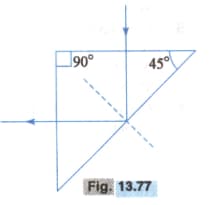Embibe Experts Solutions for Chapter: Ray Optics and Optical Instruments, Exercise 1: Exercise
Embibe Experts Physics Solutions for Exercise - Embibe Experts Solutions for Chapter: Ray Optics and Optical Instruments, Exercise 1: Exercise
Attempt the practice questions on Chapter 9: Ray Optics and Optical Instruments, Exercise 1: Exercise with hints and solutions to strengthen your understanding. Physics Crash Course (Based on Revised Syllabus-2023) solutions are prepared by Experienced Embibe Experts.
Questions from Embibe Experts Solutions for Chapter: Ray Optics and Optical Instruments, Exercise 1: Exercise with Hints & Solutions
Write a short note on prisms making use of total internal reflection.
Define critical angle. Explain total internal reflection using a neat diagram.
Explain the formation of a mirage.
A ray of light incident normally on one face of a right angled isosceles prism is found to be totally reflected Fig. . What is the minimum value of the refractive index of the material of the prism? When the prism is immersed in water, trace the path of the emergent ray for the same incident ray, indicating values of all the angles. .

A point source of light is placed at the bottom of a vessel containing a liquid of refractive index . A person is viewing the source from above the surface. There is an opaque disc of radius flowing on the surface. The centre of the disc lies vertically above the source . The liquid from the vessel is gradually drained out through a tap. What is the maximum height of the liquid for which the source cannot at all be seen from above ?
Find the angular dispersion between red and blue rays of light produced by a flint glass prism of refracting angle . The refractive indices of flint glass for red and blue light are and respectively.
What is dispersion?
What is dispersion? Obtain the equation for the dispersive power of a medium.
